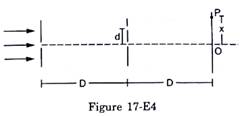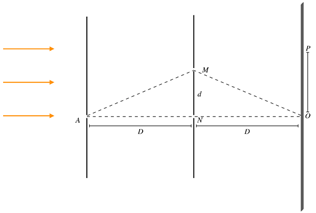Consider the arrangement shown in figure (17-E4). The distance D is large compared to the separation d between the slits. (a) Find the minimum value of d so that there is a dark fringe at O. (b) Suppose d has this value. Find the distance x at which the next bright fringe is formed. (e) Find the fringe-width.

To get a dark fringe at O, the path difference between the two rays coming from M and N should be ![]() .
.

The geometrical path difference is given by ![]()
Here, ![]() and
and ![]()
![]()
Therefore, to have a minimum at O,
![]()
Solving the above equation, we get,
![]()
Squaring both sides,
![]()
Ignoring ![]() as its very small in comparison with other two.
as its very small in comparison with other two.
![]()
To have minimum d, n=0.

(b) Here, ![]() . The width of the dark fringe would be
. The width of the dark fringe would be
![]() .
.
This fringe is both above and below O. After this dark fringe would be the first bright fringe. So we divide it by two, to locate the bright fringe. Here, the location is given by x.


(c) From the above problem, ![]()
![]()